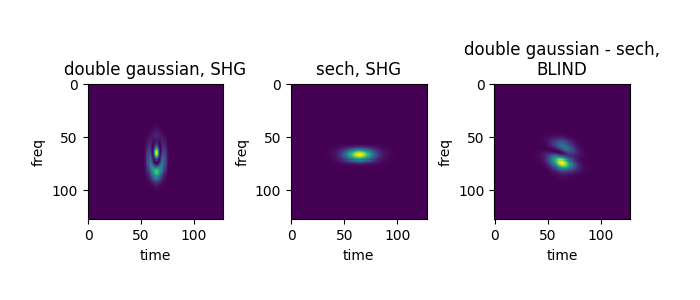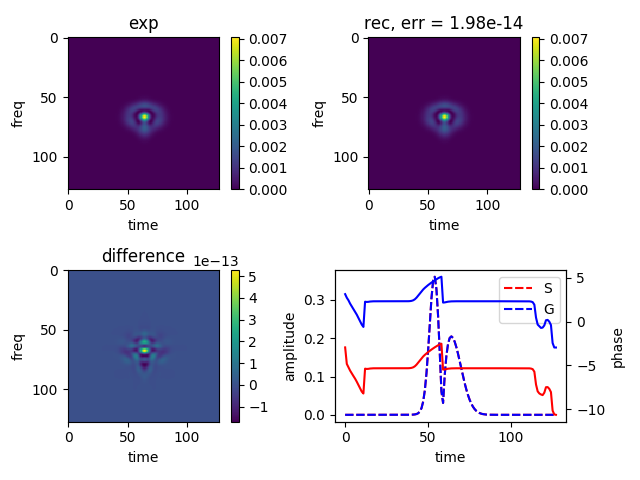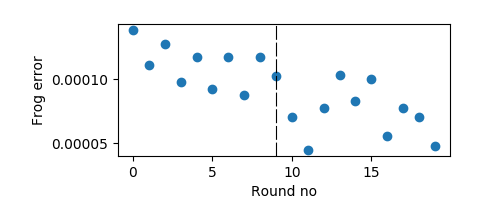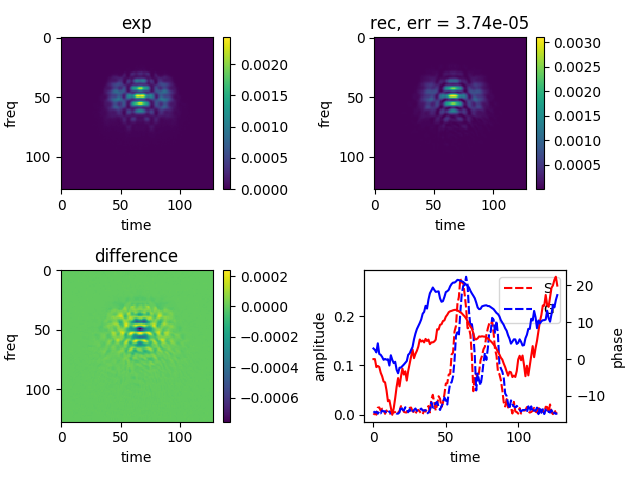A library to reconstruct the complex optical field of short optical pulses from FROG (Frequency Resolved Optical Gating[1]) traces.
For a comprehensive overview on the FROG technique, see:
Trebino, Rick. Frequency-resolved optical gating: the measurement of ultrashort laser pulses.
Springer Science & Business Media, 2012.
- generate artificial FROG traces for Second Harmonic Generation (SHG) and Blind FROG setup
- basic implementation of the PCGP (Principle Components Generalized Projection) algorithm
- basic reconstruction loops
- basic functions to remove simple ambiguities
- tools to calculate the field with errorbars from a list of reconstructed fields
-
A full-feature, ready-to-use end user program. In general, several unforeseeable things may happen when reconstructing a FROG trace. Even simple ambiguities are sometimes hard to detect automatically. Reconstruction sometimes tends to stick at traces with small Frog errors, which for the human inspector are clearly different from the experimental traces. In general, human interaction and judgement is unavoidable.
-
Automatic calibration. Time and frequency grid of a FROG trace have to be choosen according to the Fourier relation. Possibly, measure traces have to be stretched accordingly before starting reconstruction.
All calculations in froglib are done in normalized units (pixel).
import numpy as np
from matplotlib import pyplot as plt
import matplotlib
from froglib import *
tvec = np.linspace(-8,8, 128)
#double pulse
t0=0.4
deltat = 0.7
signal1 = np.exp(-((tvec+deltat/2)/t0)**2) - np.exp(-((tvec-deltat/2)/t0)**2) * np.exp((-(tvec-deltat/2)/t0 * -1j))
signal2 = 1./np.cosh(tvec) * np.exp(1.0j * (0.6 * tvec + 0.5 * tvec**2))
# generate traces
F1 = frogtr(signal1, signal1, mode='shg')
F2 = frogtr(signal2, signal2, mode='shg')
F3 = frogtr(signal1, signal2, mode='blind')
# plot traces
spp = matplotlib.figure.SubplotParams(wspace=0.5)
plt.figure(figsize=(7,3), subplotpars=spp)
ax1= plt.subplot(131);plt.title("double gaussian, SHG")
plt.imshow(np.abs(F1)**2)
ax2= plt.subplot(132);plt.title("sech, SHG")
plt.imshow(np.abs(F2)**2)
ax3=plt.subplot(133);plt.title("double gaussian - sech,\nBLIND")
plt.imshow(np.abs(F3)**2)
for ax in [ax1,ax2,ax3]:
ax.set_xlabel("time")
ax.set_ylabel("freq")
import numpy as np
from matplotlib import pyplot as plt
from froglib import *
# generate signal
tmax = 7
N = 128
tvec = np.linspace(-tmax, tmax, N)
deltat = 0.5
freqoff = 1.2
#two gaussians of different height and width, different freqs
field = 0.5 * np.exp( - (tvec-deltat)**2) - np.exp( - (tvec+deltat)**2/0.5**2) * np.exp(1.0j * freqoff * tvec)
# generate artifical trace (SHG)
Mexp = np.abs(frogtr(field, field, mode='shg'))
# use a simple loop of the PCGP algorithm
res = simplerec(Mexp, iterations=150)
# show result
simplerecresult(Mexp, res)
plt.show()
The result of the reconstruction is stored in the dictionary res:
(keys) : (values)
errors : Array holding Frog error for each iteration
gp, sp : Arrays with signal and gate fields for each iteration
minerror : minimal Frog error that occured during iterations
min_sp, min_gp : signal and gate pulses for minimal Frog error
mode : mode used ('shg' or 'blind')
exp : experimental trace (amplitude)
The basic idea behind this is to make several attempts to reconstruct a trace. Each attempt initially is only iterated some steps. Then, the best 'candidate' is chosen and iterated fully. Both SHG and Blind FROG reconstructions are attempted. Usually, due to the fact that experimental SHG FROG traces show a slight asymmetric shape, be it due to noise or misalignment, the Blind part will give better result.
When SHG traces are reconstructed with in 'blind' mode, both reconstructed signal and gate pulse will look very similar albeit phase/time ambiguities.
For more information, see
Hause, A., et al. "Reliable multiple-pulse reconstruction from second-harmonic-generation
frequency-resolved optical gating spectrograms." JOSA B 32.5 (2015): 868-877.
import numpy as np
from matplotlib import pyplot as plt
from froglib import *
M = np.loadtxt("example_data/stronglychirpeddouble.dat")
Mexp = np.sqrt(M)
res = mixfrog(Mexp, startnum=10, plot=True )
plt.show()
froglib is free software: you can redistribute it and/or modify it under the terms of the GNU General Public License as published by the Free Software Foundation, either version 3 of the License, or (at your option) any later version.
froglib is distributed in the hope that it will be useful, but WITHOUT ANY WARRANTY; without even the implied warranty of MERCHANTABILITY or FITNESS FOR A PARTICULAR PURPOSE. See the GNU General Public License for more details.
You should have received a copy of the GNU General Public License along with froglib. If not, see http://www.gnu.org/licenses/.
Contributors:
- Christoph Mahnke, 2018 (chmhnk_at_googlemail_dot_com)





